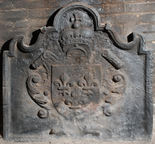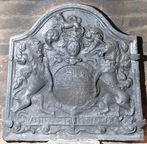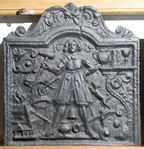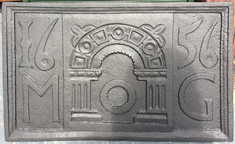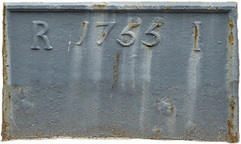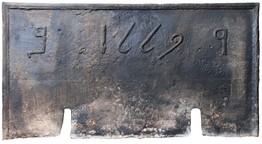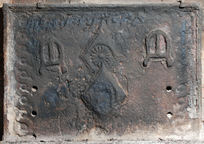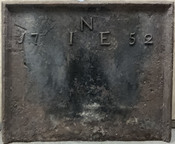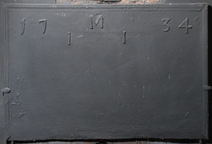-
659
Description: Rectangular with complex quasi-arched rectangular top; ovolo moulded edging; shield with Royal arms of France in a cartouche; above, an English crown.
Notes: A different version of no. 488. The combination of the English crown and French arms is common and may relate to the marriage of Charles I and Princess Henrietta Maria of France in 1625; probably the work of the same pattern maker. Many copies exist of this fireback.
Copies of this fireback are known.
Arms: French royal
- Decoration tags:
- rectangular with round arch (shape)
- ovolo (edging)
- whole carved pattern
- armorial
- royal
Manufactured: in the early- to mid-17th century in the Weald area of England.
Current location: in private hands, Rolvenden, Kent, England.
- Attached to series:
- Ornate border series
- Miscellaneous royal firebacks
- Anglo-French armorial firebacks
-
666
Description: Inclined rectangle with ogee arch; fillet and ogee moulded edging; garter enclosing English Stuart royal arms, with supporters, helm, crest, mantling and motto.
Notes: Standard armorial design; the inclined shape is uncommon.
Inscription: [Garter motto illegible] DIEV ET MON DROIT
Arms: English Stuart royal
- Decoration tags:
- rectangular with round arch (shape)
- ovolo (edging)
- whole carved pattern
- armorial
- royal
- text
Manufactured: in the 17th century in England.
Current location: in private hands, Rolvenden, Kent, England.
- Attached to series:
- Stuart royal armorial firebacks
-
667
Description: Armorial within complex ovolo moulded edging (top and sides); quartered shield, helm, crest and mantling; plain panel below.
Notes: The arms can be identified from the first four quarters on the memorial to Raffe Maynard, d.1613, in St Albans Cathedral; quarterly, 1, Maynard: argent, a chevron azure between three sinister hands couped at the wrist gules; 2, Filleigh: gules, a fess vairy between six crosses formy or; 3, Harris/Hawes/Hewish: gules fretty argent a canton of the second; 4, Lyons: argent a chevron sable between three lions dormant coward gules; the crest, a stag statant, is of Maynard. The Maynards, originally from Devon, were a large family in Rotherfield, and Richard Maynard (d.1619) had an interest in Old Mill, Mayfield, as well as in Birchden forge, and probably Hamsell furnace. An example without the extension panel at the bottom has been noted. A larger fireback with the same arms, and probably by the same pattern maker, can also be seen (no. 144).
Copies of this fireback are known.
Arms: Maynard
- Decoration tags:
- rectangular with round arch (shape)
- ovolo (edging)
- whole carved pattern
- armorial
Manufactured: in the late-16th century in the Weald area of England.
Current location: Hole Park, Rolvenden, Kent, England.
- Attached to series:
- Personal armorial firebacks
- Ornate border series
- Maynard arms firebacks
-
668
Description: Arched rectangular shape with symmetrical floral scrolls on top; three horizontal plank lines; ovolo moulding all round edge of main panel; central figure of a bearded man wearing knee-length coat, belted at waist, and holding a sledge hammer in his right hand, his left arm akimbo; various ‘tools’ of his trade arranged about him; (clockwise from top left) a circular cartouche with a central bead; the date split on either side of his head; a floral console supporting a shelf bearing a flagon, a tankard and a goblet; a circular cartouche with a central bead, a mirrored image of the one in the top left corner; from the top of the cartouche a dog leaping up at its master; between the man’s legs a long-handled ladle, a weight and a cooking pot; a ringer, used to pull slag off molten iron; part of the elevation of a blast furnace, with wooden framework, casting house, and flames issuing from the top; an ore basket, wheelbarrow and a charcoal clamp.
Notes: A pastiche of the 1636 original Lenard fireback (no. 429), now often mistaken for it; the inscription is missing, as are the fireback and the shield each being replaced by a form of cartouche; the figure of the man is more naturalistically modelled, yet wearing similar clothes; his feet face outwards.
Copies of this fireback are known.
Inscription: 1639
- Decoration tags:
- rectangular with round arch (shape)
- ovolo (edging)
- whole carved pattern
- pictorial
- text
- humans
- objects
Manufactured: in the 18th century possibly in the Weald area of England.
Current location: Rottingdean Grange, The Green, Rottingdean, East Sussex, England.
(part of the Brighton Museum museum group)
- Attached to series:
- Miscellaneous pattern firebacks
-
1099
Description: Rectangular shape; ovolo-moulded edging; raised central rectangular panel with inset stylised design of a rounded arch upon Ionic columns, the inside edge indented; at quarter angles outside the arch, two trefoils; within the arch, sequence of linked hollow strapwork rhomboids and circles; between the columns, a roundel with the internal edge indented; left of the central panel, 16 above upper-case M in low relief; right of the central panel, 56 above upper-case G in low relief.
Notes: An unusually small but well-preserved back with a stylised design. The style of the numerals, particularly the 6 and 5, can be seen on a larger fireback of 1653.
Copies of this fireback are known.
Inscription: 16 56 / M G
- Decoration tags:
- rectangular (shape)
- ovolo (edging)
- carved stamps
- whole carved pattern
- individual letters
- individual numbers
- architectural
- text
Manufactured: in 1656 in the Weald area of England.
Current location: Avery Way, Tamar View Industrial Estate, Saltash, Cornwall, England.
- Attached to series:
- 1650s Wealden series
-
1287
Description: Rectangular shape; ovolo-moulded edging; top centre, date between split initials.
Notes: The letters and numerals are particularly well formed. The fireback is displayed out of doors against a wall at the side of the street and the lower part is recessed into the pavement.
Inscription: R 1755 I
- Decoration tags:
- rectangular (shape)
- ovolo (edging)
- carved stamps
- individual letters
- individual numbers
- text
Manufactured: in 1755 possibly in the Weald area of England.
Current location: 15-17 High Street, Seaford, East Sussex, England.
- Attached to series:
- Date & initials firebacks
-
903
Description: Rectangular; ovolo-moulded edging (top and sides); date between split initials across upper half of plate; two notches cut away for insertion of firedogs.
Notes: The ‘6s’ appear to have been moulded from a type of jemmy.
Inscription: g 1669 P [reversed]
- Decoration tags:
- rectangular (shape)
- ovolo (edging)
- simple stamps
- carved stamps
- individual letters
- individual numbers
- text
- objects
Manufactured: in 1669 possibly in the Weald area of England.
Current location: George & Dragon Inn, Speldhurst Hill, Speldhurst, Kent, England.
- Attached to series:
- Andiron slot firebacks
- Metalware stamp firebacks
- Miscellaneous stamp firebacks
-
829
Description: Rectangular; ovolo-moulded edging (top and sides); repeated guilloche pattern inside top and side edges; upper centre, lozenge stamp with ovolo edges and recessed daisy flower in centre, between buckle stamp repeated twice; the lozenge stamp is repeated over-stamping the lower part of the first.
Notes: The lozenge stamp is a design also seen on domestic interior panelling; the buckles suggest a Pelham family association; the buckle and lozenge are separate stamps, and in each example their relative positions differ slightly; the guilloche design appears to have been carved on the base panel; an example at The Star Inn, Alfriston, Sussex measures 665mm x 480mm.
- Decoration tags:
- rectangular (shape)
- ovolo (edging)
- carved stamps
- carved pattern panels
- heraldic
- objects
Manufactured: in the early- to mid-17th century in the Weald area of England.
Current location: in private hands, Iford, East Sussex, England.
- Attached to series:
- Pelham family firebacks
- Pelham buckle and lozenge series
- Metalware stamp firebacks
-
1249
Description: Rectangular; bold ovolo-moulded edging (top and sides); at top, date widely split by initials in triad.
Notes: Characteristic lettering and numerals of the mid-18th century. The triad of initials probably refer to a husband and wife, the central initial N being that of their surname.
Inscription: 17 INE [triad] 52
- Decoration tags:
- rectangular (shape)
- ovolo (edging)
- carved stamps
- individual letters
- individual numbers
Manufactured: in 1752 possibly in the Weald area of England.
Current location: Authentic Reclamation, Lymden Lane, Ticehurst, East Sussex, England.
- Attached to series:
- Date & initials firebacks
-
961
Description: Rectangular; ogee-moulded edging on top and side edges; symmetrical layout of date and initials; date split between left and right sides, initials in centre, arranged in triad.
Notes: One of a series of backs dating to the 1730s and 40s using very similar sets of letters and numerals.
Inscription: 17 I M I 34
- Decoration tags:
- rectangular (shape)
- ovolo (edging)
- carved stamps
- individual letters
- individual numbers
- text
Manufactured: in 1734 in the Weald area of England.
Current location: in private hands, Titsey, Surrey, England.
- Attached to series:
- 1730s-40s, date & initial series
